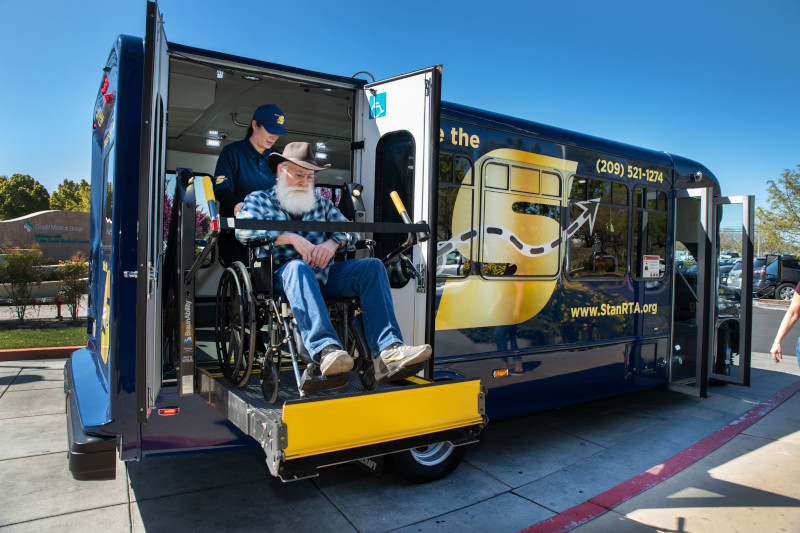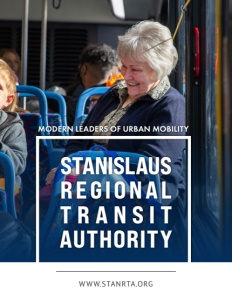Stanislaus Regional Transit Authority
Stanislaus Regional Transit Authority: Modern Leaders of Urban Mobility
Operational consolidation and structural expansion play a vital role in connecting Stanislaus County communities
In an era marked by an abundance of personal transportation options, the bus transit industry has proven itself as a resilient and adaptive force. A transit authority is not merely a means to connect people from point A to point B; it’s the backbone of a region’s vitality and progress.
It’s about more than buses on the road; it’s about connecting people to their dreams and opportunities. Navigating the intricate web of transportation logistics, addressing diverse community needs, and achieving financial sustainability are just some of the hallmarks needed to make that vision a reality.
For years, the transportation industry has faced formidable hurdles, from increasing urbanization and environmental concerns to shifting commuter preferences.
Excellence in this sector demands not only dedication but also innovation, and one prime example of this shines through in the achievements of the Stanislaus Regional Transit Authority.
It stands as a beacon of success with a journey that showcases the immense potential of transit authorities to not only overcome obstacles but to excel and shape the future of transportation in their communities.
From streamlining operations to embracing eco-friendly initiatives, it has paved the way for its community to flourish. It offers us a glimpse of what a bright and interconnected future of public transit should look like.
 Optionality as an Operational Foundation
Optionality as an Operational Foundation
The Stanislaus Regional Transit Authority (StanRTA) is a public transportation agency that provides bus services in Modesto, California, and throughout Stanislaus County.
The agency also operates under the name “The S” and, in 2021, consolidated a number of different transit services under its name. Due to this merger, the key feature of its operational prowess now revolves around the large breadth of services that are available to help the public get where they need to go throughout the County instead of just focused on one city.
It offers a range of services, including local fixed-routes, express commuter service to the ACE (Altamont Commuter Express) train station in Lathrop, the BART station in Dublin/Pleasanton, and the Amtrak station in Modesto.
The agency goes the extra mile by also providing a complementary ADA paratransit service that’s available for those who are disabled and can’t use the traditional fixed route bus.
Finally, for those who don’t need massive bus routes, the agency also offers demand response services for smaller communities that are available upon request for those who only need to travel locally.
Whether you’re a daily commuter heading to work, a traveler seeking to connect with regional rail networks, a person with disabilities in need of specialized assistance, or a resident looking for efficient local transportation, “The S” has it all covered.
Their comprehensive approach to transit ensures that everyone, regardless of their unique circumstances or requirements, can access reliable and efficient transportation.
This commitment to convenience and inclusivity is clearly underscored by the diverse array of services they offer to the public.
Major Upgrades on the Horizon
Despite already having such an effective lineup of transit options, the StanRTA is still looking to improve its services in both quantity and quality.
According to StanRTA CEO Adam Barth, “California has a mandate that all public transit systems start to purchase new vehicles as part of its plan to replace diesel and gasoline vehicles with zero-emission buses.”
Currently, the StanRTA has five-zero emission electric vehicles. However, their attempts at compliance have resulted in certain technology-related obstacles.
“So, we found that on the coldest days here, the [electric] buses only get about 100 hundred miles of range, and they need to have about 200-300 miles of range to operate the entire day,” Barth explains.
With an average charge time of six hours, relying solely on electricity isn’t the best option; therefore, the agency has devised a brilliant alternative that still complies with the California zero-emission mandate.
It has decided to purchase buses powered by hydrogen, as the engine technology is still zero-emission and does not suffer the same range limits that electric buses do. Currently, the agency is planning the fueling infrastructure for the buses and will be purchasing its first three buses in the near future.
Luckily, since these types of buses have been used widely by other transit systems, it’s proven technology that Barth and the rest of the StanRTA know that they can consistently rely on.
As of today, the agency has one hundred and thirty buses in its fleet, so converting the entire fleet and fueling infrastructure will be completed around 2040.
“We’re looking to build a new shop to accommodate both hydrogen [fueling] and also for expansion as well. Since we’re at capacity in our current facility, we’re not able to expand our operation,” Barth explains, drawing attention to the fact that the facility expansion is intended to bring StanRTA’s multiple teams into the same physical location.
“ That includes the administration team, the operations team, and maintenance team, [if] we’re all under the same roof, I think it will really provide some synergies between us that will provide a much better service to the customer,” Barth says.
Additionally, the agency is also working towards making its facilities generally more carbon neutral, as well as more secure for all of the drivers and support staff. However, these operational expansions, while much needed, actually fit within a larger plan to expand transit services.
“Bus Rapid Transit or BRT is a service that provides frequent service down corridor… think of it as a little light rail on rubber wheels, where the line often has a dedicated lane.”
This new service will come with a unique brand of platform bus stops, will have traffic signal priority, and is intended to replicate the practicality of light rail stations without needing as much modification to the already existing road structures.
 Essential Partnerships of the StanRTA
Essential Partnerships of the StanRTA
With all of these changes and expansions already underway and scheduled for the future, some things simply have to remain constant in order for everything to work smoothly.
In this case, it’s the two third parties that act as the logistical backbone of the StanRTA.
On the operational side of things, there is Transdev, which provides the agency with innovative ways to run its operation and reduce costs.
This company essentially manages the majority of the transit authority. “All of our drivers and support staff are actually employed through them,” Barth says, explaining that this is a common occurrence, as many transit systems in the US also contract for transit services from third party operators.
Since the availability of bus drivers is always in a state of flux, with drivers coming and going, Transdev is the entity that ensures that all incoming drivers receive adequate training and testing within the appropriate time frame, which is usually one to two months.
Due to this, as the overseers, the Transdev operators are usually looking ahead and forecasting how many drivers they’ll need within that same one to two-month time frame.
According to Barth, because Transdev always has their training regimen active and in place, when it comes to driver availability, “it’s not as big as of a concern [as] it is in other places where they really have a shortage of drivers.”
The City of Modesto handles vehicle maintenance and the recruitment and training process for maintenance staff.
On the technology side of things, the agency is partnered with Avail Technologies, which provides support with computer-aided dispatch and automatic vehicle location systems, which are used to track the entirety of the bus fleet.
While dispatchers can use this technology to keep tabs on the fleet, it is also used as a method of communication to the general public that rides the bus. This dispatch information is also shown to the public via an app where riders can see bus routes, as well as their specific bus location, in real time.
“It’s good to have that information; that way, people can make their own decisions on how to move forward… so that app has played a key role in how we communicate information to our ridership,” Barth says.
The Results of Proper Planning and Synergy
With such strong support systems in place, it’s clear that the StanRTAs service has certainly served the public well, and the results have been incredibly positive for the public.
“Ridership for us has just exploded the last few months. We are seeing more people on the bus routes than we have in the past, even before COVID-19,” Barth says, explaining that the increase in riders is likely due to the 2021 merger of transit services within Stanislaus County.
“I think the consolidation made it a whole lot easier for folks to travel around the county, as people didn’t have to buy different passes or try to figure out different websites or routes. It all came under one roof, so the consolidation really helped prompt transit as a primary mode of transportation.”
This makes sense, as convenience is usually one of the most important factors for the growth of any service. Since StanRTA plans to expand, there is no doubt that the effects on ridership will continue to be positive and impactful.
AT A GLANCE
Stanislaus Regional Transit Authority
What: Regional Transit Authority leading the way in urban mobility and connecting communities in Stanislaus County.
Where: Modesto, California, USA
Website: https://stanrta.org/



